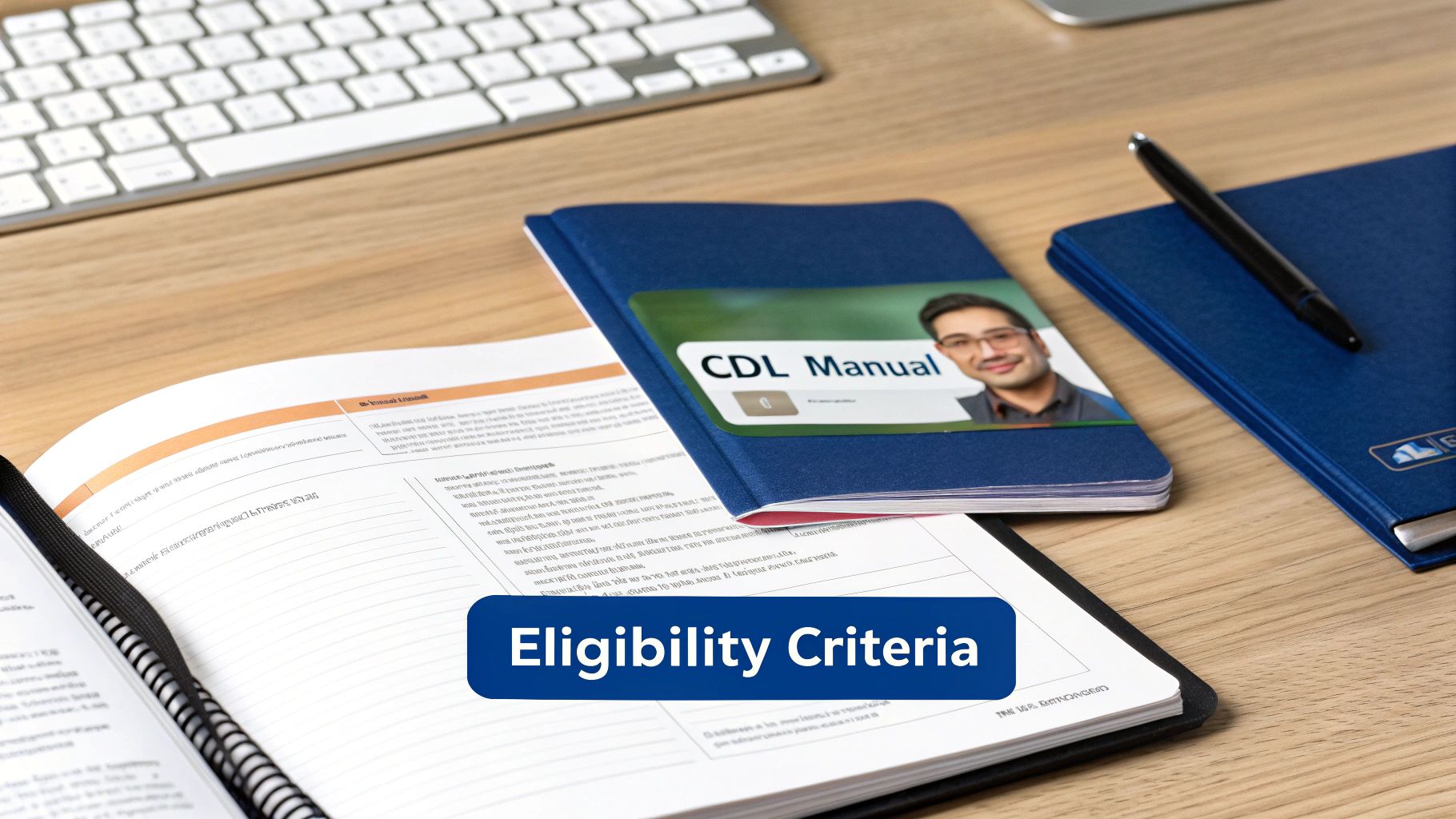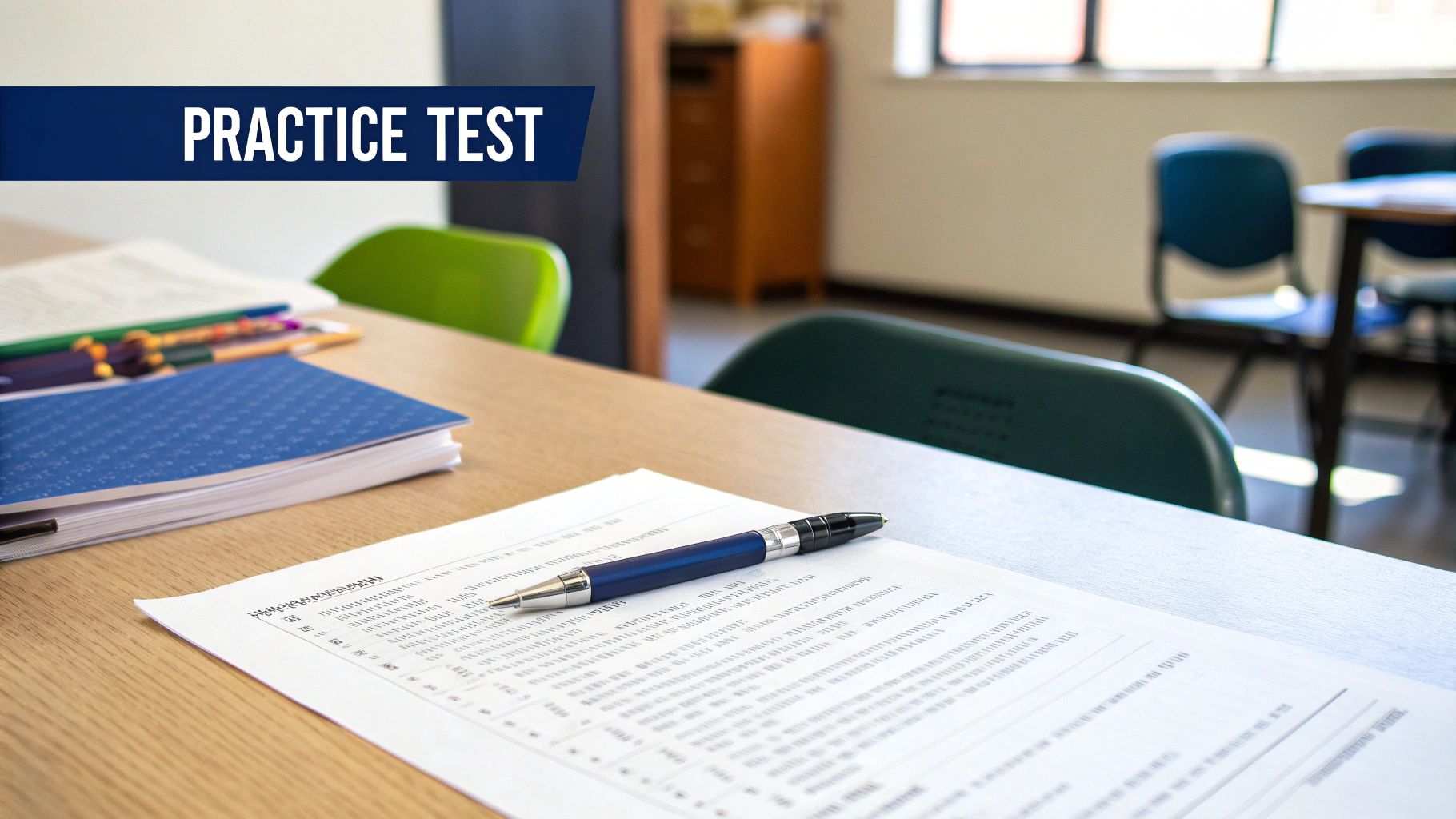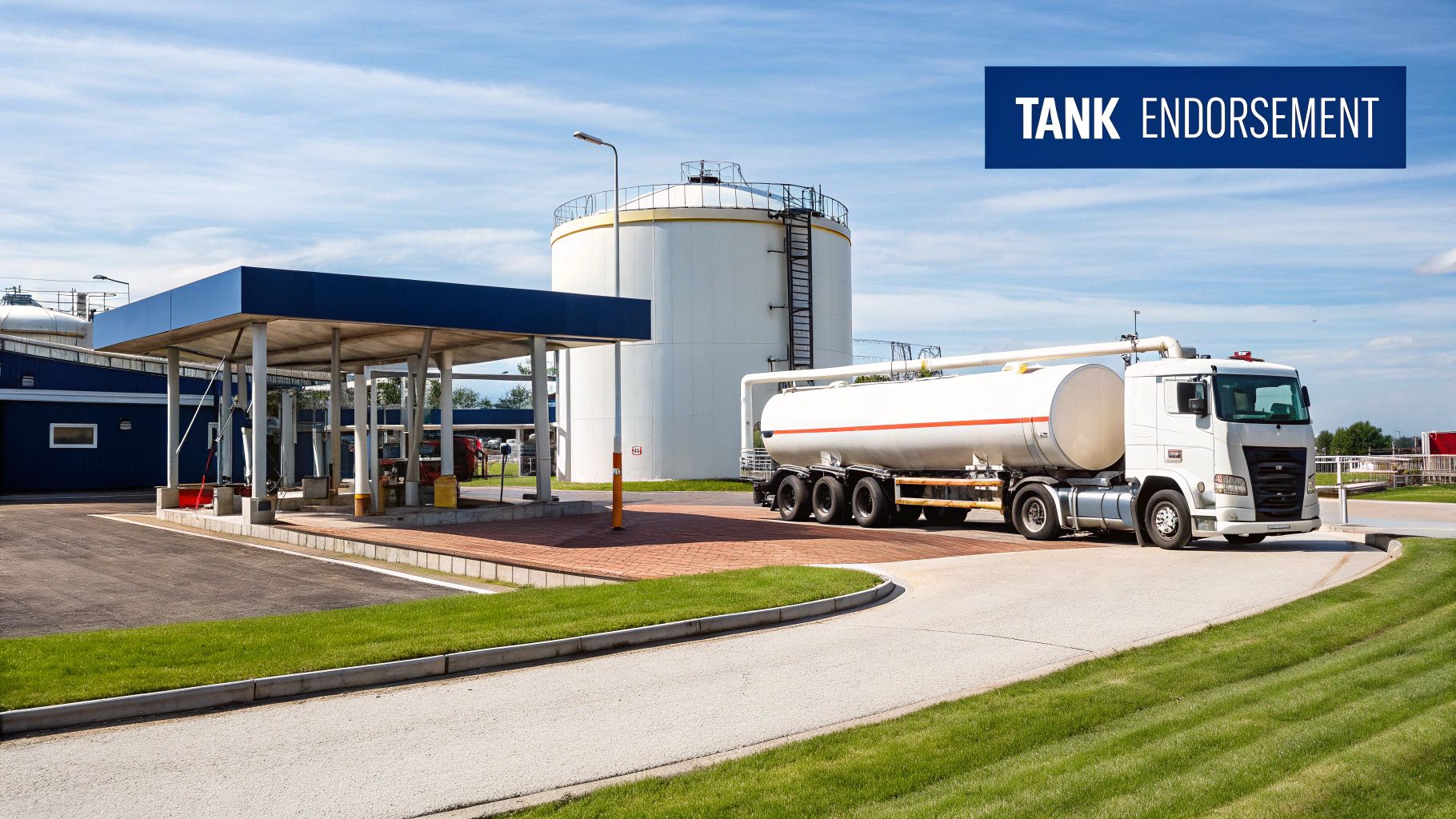CDL Tank Endorsement Test | Simple Guide That Works
So, you’re thinking about getting your tanker endorsement. Let’s get straight to it: this isn’t just another checkbox on your CDL. Earning that ‘N’ endorsement is a direct route to better paychecks and more specialized job opportunities. While dry van and reefer loads provide steady work, tanker jobs often pay more because you're dealing with a different kind of freight and a unique set of challenges.
This endorsement opens up the door to hauling all sorts of liquid cargo. Think about the possibilities:
- Fuel delivery: This is a huge one. You could be the driver keeping gas stations and truck stops running.
- Food-grade hauling: Transporting milk, juice, or corn syrup is a massive industry that requires clean, dedicated tankers.
- Chemical transport: This often requires a Hazmat (H) endorsement as well, but it’s some of the highest-paying work you can find.
The CDL tank endorsement test is your first hurdle. It’s not about memorizing random facts; it’s about understanding why hauling liquids is so different. The biggest reason is liquid surge—that powerful sloshing motion that can push your truck around, especially in turns or during sudden stops. This is exactly why the Federal Motor Carrier Safety Administration (FMCSA) requires this specialized training.
What to Expect From the Test
The Commercial Driver's License (CDL) Tanker Endorsement test is a written knowledge exam for drivers who want to operate tank vehicles carrying liquids or gases, typically in amounts over 1,000 gallons. This test is mandatory for all CDL classes—A, B, or C—if you're pulling a tank. The questions focus on the unique safety issues of tank vehicles, like the high center of gravity and the powerful effect of liquid surge.
You’ll usually face about 20 multiple-choice questions and need to score at least 80% to pass. The cost and other requirements can vary a bit depending on where you live.
To give you a clearer picture, here’s a quick look at how test requirements can differ across a few states.
CDL Tank Endorsement Test Requirements by State
Compare test fees, processing times, and additional requirements across different states.
Key takeaway: While the federal knowledge requirements are the same everywhere, the fees are a state-by-state affair. The good news is that in most places, you can get your endorsement processed the same day you pass the test.
Passing means you’re officially qualified to handle these dynamic loads. If you don't pass the first time, don't worry. Most states let you retake it, though you might have to wait a day or two and pay the fee again. The key is to understand the why behind the rules, not just the rules themselves. This endorsement proves you know how to manage the unique physics of liquid freight, which makes you a more valuable and safer driver on the road.
The Real Story Behind These Safety Rules

Here’s something most driving schools won't tell you: the rules on your CDL tanker endorsement test weren't dreamed up in an office. They were written in response to real-world accidents, some of them fatal. When you’re studying things like outage, baffles, and surge, you’re learning lessons that other drivers learned the hard way.
This is serious business, and knowing the history behind these regulations helps the information stick. Every rule exists for a reason, and usually, that reason is to prevent a tragedy from repeating itself. That's why every single question on the test is tied to a situation you could genuinely face on the road.
Why the Feds Stepped In
Before the 1980s, the trucking world was a bit like the Wild West. Each state made its own rules for licensing drivers. A trucker could get licensed in a state with easy standards and then drive a tanker full of hazardous liquid through a state with much stricter safety laws. This patchwork system created huge safety gaps, and serious tanker accidents started making headlines, forcing the government to take action.
This inconsistency led directly to the creation of the federal Commercial Driver’s License program. The government saw that a standard system was necessary to ensure every driver hauling specialized loads, like liquids, met the same safety requirements. The goal was to make sure a driver qualified in one state was just as safe to operate in any other. You can find out more about how federal standards shaped today's road tests on the FMCSA’s official site.
Stricter Rules for a Safer Road
Even after the CDL program was up and running, the rules kept evolving. The federal government monitors accident data and industry practices, tightening regulations when they spot a problem. For instance, in 2013, the definition of a "tank vehicle" was updated to specifically include those carrying 119 gallons or more in portable tanks.
This history explains why, even with a brand new endorsement, employers will still put you through their own road tests. They want to see your skills for themselves because they are ultimately responsible for what happens on the road. Some companies even have tougher rules than the feds, especially if they haul sensitive materials.
The key takeaway is this: understanding the "why" behind these regulations doesn't just help you pass the test. It makes you a safer, more professional driver who understands the true weight of your responsibility.
Breaking Down What You Actually Need To Know

Alright, let's get into the details of what you really need to focus on for the cdl tank endorsement test. This isn’t about just memorizing facts to pass. It’s about truly understanding what happens when you have thousands of gallons of liquid shifting around behind your cab. The test focuses on a few core areas: how liquids behave on the move, safe loading and unloading, and the special equipment you'll be using.
Liquid Surge and Tank Design
The single most important concept on the test is liquid surge. This isn't just a term to know—it's a powerful force created by moving liquid that can push your truck straight through an intersection or even cause a rollover. A half-full tank is often more dangerous than a full one because the liquid has more room to build momentum. Think about carrying a big bucket of water; if you stop short, the water slams forward and pushes you. Now imagine that force multiplied by several thousand gallons.
The exam will want to see that you understand how different tanks are designed to control this surge:
- Baffles: These are walls inside the tank with holes that let liquid flow through slowly. They don't stop the movement, but they disrupt it enough to make the surge far less aggressive.
- Bulkheads: Unlike baffles, these are solid dividers that create completely separate, smaller tanks inside the main shell. A tank with baffles is one big compartment, while a bulkheaded tank has multiple compartments.
- Smooth Bore Tanks: These are the wild ones with no baffles or bulkheads inside. They're often used for loads like milk that require total cleaning between uses. Because there's nothing to slow the surge, they demand the most skill and care from the driver.
Weight, Balance, and Safety Procedures
A tanker truck has a much higher center of gravity than a standard dry van, which makes it more top-heavy and prone to rolling over. You can expect questions about how to manage this high center of gravity, particularly when navigating curves and highway on-ramps.
Proper loading and unloading are also a huge deal. The test covers why you must ground your truck to prevent static sparks (a must when hauling fuel) and the importance of checking for leaks before you drive off. You'll also need to know about "outage" or "ullage," which is the empty space you leave at the top of the tank to allow for liquid expansion as temperatures change.
These rules exist for a reason. The federal government updated regulations in 2013 to standardize the definition of a tank vehicle, which now applies the endorsement rule to any tank rated for over 1,000 gallons. This ensures drivers hauling significant amounts of fuel, milk, or chemicals all meet the same high safety standards. You can read the specifics of how the FMCSA defines tank vehicles on their official registry. Nailing these core concepts is a major part of any good Class A CDL theory program and will put you in a great position to pass.
Study Methods That Work For Busy Drivers

Let's be realistic—your schedule as a driver is already packed. Finding the time to study for the cdl tank endorsement test between hauls, appointments, and your 10-hour break can feel like an impossible task. The secret isn't to find huge blocks of time, but to use the small windows you already have.
Forget about cramming for hours on end. The best approach is what you might call "micro-studying." This is all about turning downtime into productive study time. Stuck at a shipper for 30 minutes? That's a perfect opportunity to run through a practice quiz on your phone. Taking a break at a truck stop? Pop in your headphones and listen to a YouTube video explaining liquid surge or outage. It's about consistent, small efforts that add up.
Making the Most of Practice Tests
Simply taking practice tests over and over again is not a winning strategy. The real learning happens when you dig into why you got a question wrong. Did you misunderstand a key concept, like the high center of gravity in a smooth bore tanker, or did you just skim the question too fast?
Every time you miss a question, don't just memorize the correct answer. Go back to your CDL manual or study guide and reread the section on that topic until it makes sense. Think of each incorrect answer as a signal pointing you directly to what you need to focus on. A lot of drivers make their own notes focused only on the questions they consistently miss. This targeted approach saves valuable time and builds confidence.
Finding the Right Study Materials
You don’t need to spend a fortune to get ready for your tanker test. While paid apps and programs can offer structured learning, plenty of free resources are just as effective. Your state’s official CDL manual should be your primary source—it’s literally the book the test is written from. Many seasoned drivers suggest using the manual alongside free online practice tests to get comfortable with how questions are phrased.
To help you decide what's best for your schedule and budget, here’s a quick comparison of the most common study resources available.
Understanding Liquid Movement and Tank Dynamics
This is where the rubber meets the road—literally. Getting a grip on how liquid moves inside a tank isn't just about passing the CDL tanker endorsement test; it's about staying safe on the job. The biggest concept you need to master is liquid surge, which is the powerful sloshing motion of your cargo. If you don't respect that force, you're setting yourself up for a rollover. It can push you forward when you brake or shove your trailer sideways in a turn.
Not all liquids are created equal, either. Gasoline sloshes differently than thick, viscous molasses. That's why you'll see different tank designs. For example, some tanks have baffles, which are internal walls with holes in them. They're designed to disrupt the forward-and-back surge, slowing the liquid down. But make no mistake: they don't stop it completely. Smooth driving is still your best defense.
The Dangers of Surge and High Center of Gravity
Curves, on-ramps, and sudden stops are your biggest enemies when hauling a tanker. A tanker already has a high center of gravity, which makes it more likely to tip over than a standard dry van. Now, add thousands of gallons of shifting liquid to that equation, and the risk goes way up.
Here’s something that might surprise you: a partially loaded tank is often more dangerous than a full one. With more empty space, the liquid has room to build up a powerful wave. That wave hitting the front or back of the tank feels like getting rear-ended by your own cargo. Imagine you're taking a tight highway off-ramp with a half-full tank. If you brake too hard, the surge will push your whole rig forward, potentially shoving you right through the curve.
Real-World Scenarios and Conditions
Your test will throw real-life situations at you, and you need to know how to handle them. Think about pulling up to a loading dock. If you stop too suddenly, the surge can violently jolt the truck and trailer. Or picture an emergency stop on the interstate—that liquid momentum could be strong enough to make you lose steering control.
Weather adds another layer of complexity. On a hot summer day, the liquid in your tank can expand from the heat. That's why you need to understand "outage," which means leaving enough empty space at the top of the tank to allow for that expansion. In the winter, some liquids get thicker and flow slower, changing how the surge behaves. Since many tanker jobs involve hauling fuel or chemicals, getting your Hazmat endorsement is a smart move. You can learn more about getting your Hazmat endorsement and open up more high-paying opportunities.
Truly understanding these dynamics—surge, center of gravity, and the risks of partial loads—is what separates a professional from a liability. It's the key to passing your test and building a long, safe career.
Acing The Test When It Counts
Alright, the big day is here. Walking into the DMV for your CDL tank endorsement test doesn't have to be a pressure cooker if you know what to expect. Having a solid game plan for test day can make all the difference between feeling stressed and feeling prepared. Your goal isn't just to get a passing grade; it's to walk out of there confident that you genuinely understand the principles of hauling liquid cargo safely.
Smart Strategies for the Test
When you sit down at that computer terminal, take a moment and just breathe. Most drivers finish the test with plenty of time left, so there's no need to rush. Rushing is a surefire way to make simple mistakes on questions you actually know the answers to. Make it a habit to read every single question twice before you even glance at the multiple-choice options.
What about those tricky questions where you're not 100% sure of the answer? Use the process of elimination. In nearly every question, you can immediately spot one or two answers that are obviously wrong. Cross those off your mental list first. Doing this dramatically increases your odds of picking the right one. Always bring your thinking back to the core concepts you studied: liquid surge, the high center of gravity, and proper outage. The correct answer will always align with these fundamental safety rules.
After the Test: Pass or Retake
If you don't pass on your first try, don't sweat it—it's not the end of your tanker career. It happens to plenty of good drivers. The most important thing you can do is grab your score report and study the sections you missed. Don't just give it a quick look. Those incorrect answers are your personal roadmap, showing you exactly what topics to focus on before you schedule your retake. While a failed test is frustrating, you can look into common mistakes that cause CDL test fails to better prepare for your next attempt.
Once you pass, the real journey begins. You'll receive your updated license, and it's time to start looking at job postings. Keep in mind that many employers, especially those hauling fuel or other sensitive chemicals, will require you to pass their own road test in a tanker. They need to see that you can apply all that book knowledge behind the wheel. Passing the written exam gets your foot in the door, but demonstrating smooth, safe driving skills is what ultimately lands you the job.

Making The Most Of Your New Tank Endorsement
Getting that "N" endorsement on your CDL is a huge win, but it’s really just the beginning. Now you get to put it to use and figure out what kind of tanker job is the right fit for you. Not all tanker gigs are the same—the liquid you haul directly impacts your pay, your schedule, and your daily life. Your endorsement gets your foot in the door, but a solid reputation for safety is what will really move your career forward.
Finding Your Niche in the Tanker World
The type of product inside your tank will completely shape your job. Let's break down the main paths you can take:
- Fuel Delivery: This is where a lot of drivers start. You’ll often have local or regional routes, which means more home time. The catch? You'll also need a Hazmat (H) endorsement, since gasoline and diesel are hazardous materials.
- Food-Grade Hauling: Think milk, juice, or corn syrup. These jobs can pay very well, but the cleanliness standards are no joke. A thorough "washout" between every single load isn't just a suggestion; it’s a strict rule to prevent any contamination.
- Chemical Transport: This is usually the highest-paying corner of the tanker world, but it also carries the greatest responsibility. It requires both a Tanker (N) and a Hazmat (H) endorsement, which combine to form the valuable "X" endorsement. Companies in this sector only hire drivers with spotless safety records.
What Employers Are Looking For
When you start applying for tanker jobs, companies want to see more than just your license. They’re looking for a professional who understands and respects the unique challenges of hauling liquid. Be prepared in interviews to discuss key safety principles from your training, like managing liquid surge and handling a truck with a high center of gravity.
Don't be surprised if a potential employer puts you through their own road test, even with your new endorsement. They want to see firsthand how you manage a partially loaded tanker. A smooth, controlled drive with no sudden braking or sharp, jerky turns tells them you understand the immense force of the liquid sloshing behind you.
The test is just the first step. Building a reputation as a steady, reliable driver is how you’ll earn access to the best routes and the highest-paying jobs in the industry.
Ready to take the first step toward these specialized roles? At ELDT Nation, our FMCSA-approved courses provide the training you need to pass your endorsement tests with confidence. Start your journey at ELDT Nation and get on the road to a better-paying career.

%20Endorsement%20%E2%80%93%20Online%20ELDT%20Theory%20for%20FMCSA%20Compliance.jpg)





